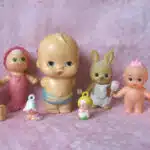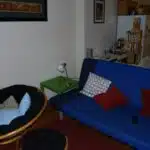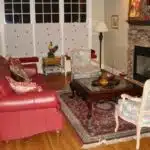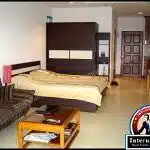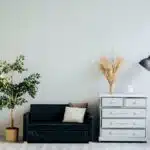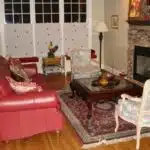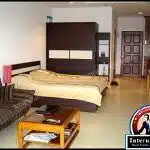Designing a nursery requires careful consideration and planning. As an interior design expert, creating a space that is both functional and aesthetically pleasing for a new bundle of joy can be a rewarding experience. The nursery is not only a space for the baby to rest and play, but also serves as a sanctuary for parents to bond with their child.
When designing a nursery, it is important to take into account the baby’s safety, comfort, and stimulation. From choosing the right color scheme to selecting furniture pieces that are practical and durable, every detail must be considered in order to create the perfect space for your little one. Furthermore, incorporating personal touches such as family heirlooms or sentimental items can add warmth and personality to the room. In this article, we will explore key elements of designing a nursery that promotes healthy development and nourishing relationships between parents and their newborns.
Safety First: Choosing The Right Furniture And Accessories
Creating a safe and secure space for your baby is essential when designing a nursery. Choosing safe accessories and furniture should be at the forefront of your mind when creating this special room. Baby proofing your space is also important to ensure that your little one stays safe while exploring their new surroundings.
When selecting furniture, opt for items that meet safety standards. Cribs with slats no more than 2 3/8 inches apart are recommended to prevent the baby from getting their head stuck. Choose dressers and changing tables with drawers that have safety stops to avoid them from accidentally falling out onto the baby. It is also essential to secure any heavy furniture to the wall to prevent tipping over.
Accessories are an easy way to personalize your nursery, but it’s vital to choose wisely. Avoid anything with small pieces or long cords which could pose a choking hazard or strangulation risk respectively. Keep in mind that babies are curious and will grab anything within reach, so make sure all accessories are out of reach and not easily dislodged.
Creating a safe environment requires careful planning, but it doesn’t have to compromise style or design. By choosing baby-proofed furniture and accessories, you can rest assured that your little one will be protected while they explore their new surroundings. In the next section, we’ll dive into creating a cohesive color palette for your nursery that will enhance its overall aesthetic appeal.
Creating A Color Palette For Your Nursery
The color palette you choose for your nursery is an essential aspect of the overall design. The right colors can create a calming and soothing environment that will help your little one sleep better. When choosing complementary colors, it is important to consider the mood you want to set in the room. For example, if you want a peaceful and relaxing atmosphere, you could choose soft pastels or muted shades of blue or green.
Using accent colors in your nursery design can also add interest and depth to the space. Accent colors are those that are used sparingly throughout the room to highlight specific areas or items. For example, you could use a bright yellow or orange as an accent on a pillow or a lampshade. Be sure not to overdo it with accent colors, as too many can make the room feel cluttered and overwhelming.
When designing your nursery color palette, don’t forget about lighting. Lighting is another critical component in creating a warm and inviting space for your baby. Consider using multiple light sources, such as table lamps, floor lamps, and overhead lighting to create layers of light in the room. You may also want to install dimmer switches so that you can adjust the brightness according to your baby’s needs.
Transition: Now that we have discussed how to create a color palette for your nursery let’s move onto the importance of lighting in nursery design.
The Importance Of Lighting In Nursery Design
Now that you have established your color palette, it’s time to focus on the importance of lighting in your nursery design. Lighting can play a significant role in creating a safe and comfortable environment for your child. It’s crucial to consider different stages of development when choosing lighting options for your nursery.
Infants require soft, ambient lighting that resembles the natural light they experienced in utero. A dimmer switch is an excellent option to control the brightness of the room as needed. This feature is also beneficial for late-night feedings or diaper changes, as it allows you to maintain a peaceful environment without disturbing your baby’s sleep. A nightlight can also offer enough light for quick checks without disrupting your baby’s slumber.
As your child grows into a toddler and preschooler, their lighting needs will change accordingly. You can add task lighting to create a cozy reading nook or brighter overhead lights for playtime activities. Ensuring adequate lighting in all areas of the room is essential to maximize safety and prevent accidents during playtime. Remember, always consider the balance between function and ambiance when selecting lighting options for different stages of development.
Now that we have covered the importance of lighting in nursery design let’s move on to maximizing space with smart storage solutions. Creating ample storage space is essential when designing a nursery, especially if you have limited square footage available. In our next section, we will discuss creative ways to incorporate storage solutions into your nursery design while maintaining a cohesive aesthetic flow throughout the room.
Maximizing Space With Smart Storage Solutions
- Vertical shelving is an excellent way to maximize storage space in any room, including a nursery.
- Utilizing the space beneath a bed is a great way to increase storage capacity in a nursery.
- Furniture pieces that serve more than one purpose are a smart choice for a nursery, as they help to reduce clutter and conserve space.
- Wall mounted shelves and cabinets can be used to store books, toys, and other items that are necessary for a nursery.
- Furniture pieces that can convert as the child grows, such as cribs that can be turned into toddler beds, can help to make the most of the space.
- Incorporating built-in storage solutions, such as shelves and drawers, can help to create a space that is organized and efficient.
Vertical Shelving
Are you looking for ways to maximize space in your nursery? Look no further than vertical shelving. This smart storage solution can be a game-changer in small spaces, allowing you to store items up and off the floor. But should you attempt a DIY installation or hire a professional? While there are plenty of tutorials available online, it’s important to consider the safety of your baby and the weight capacity of your shelves before attempting installation yourself. Hiring a professional ensures that your shelving is secure and can handle the weight of all your baby gear.
Once your vertical shelving is installed, it’s time to style with baby items. Consider using baskets or bins to corral small items like toys or diapers. A mix of open shelves and closed storage options can create visual interest while still keeping clutter at bay. Don’t forget to incorporate decorative touches like framed artwork or stuffed animals for a personal touch.
In conclusion, vertical shelving is an excellent way to maximize space in your nursery while still maintaining functionality and style. Whether you opt for a DIY installation or hire a professional, be sure to consider safety first and foremost. With thoughtful styling and organization, your vertical shelves will not only serve as practical storage but also add visual interest to your nursery design.
Under-Bed Storage
Maximizing space in a nursery is crucial for creating a comfortable and functional environment for both parents and babies. While vertical shelving is an excellent storage solution, there are other options that can help with organization and space-saving. One smart storage solution to consider is under-bed storage. Utilizing the space underneath a crib or bed can be a game-changer in small nurseries.
When it comes to under-bed storage, it’s important to choose the right type of container. Opt for low-profile containers that fit snugly under the bed frame and have wheels for easy access. Consider incorporating under-bed storage into a specific design concept for your nursery, such as using baskets or bins that match your theme. This will not only maximize storage but also add visual interest to your design.
When designing your nursery, don’t forget to prioritize comfort as well as function. Choosing the right mattress, curtains, and bedding can make all the difference in creating a cozy space for your baby. Incorporating under-bed storage into your design strategy is just one way to maximize comfort while also maximizing space.
By considering smart storage solutions like under-bed storage and vertical shelving, you can create a practical and stylish nursery that maximizes both function and comfort. Remember to choose containers that fit snugly and match your theme, and prioritize comfort when selecting bedding and other elements of your nursery design. With these tips in mind, you can create a beautiful space that serves both you and your baby well.
Multipurpose Furniture
When it comes to maximizing space in a nursery, utilizing smart storage solutions is essential. While options like under-bed storage and vertical shelving can be incredibly helpful, there’s another solution that can be just as effective: multipurpose furniture. By incorporating furniture items that serve multiple functions, you can optimize your available space while also enhancing the overall design of your nursery.
One example of multipurpose furniture is convertible cribs. These cribs can transform into toddler beds or even full-size beds as your child grows, eliminating the need to purchase additional furniture down the line. Storage ottomans are another option that can serve as both seating and storage space. They’re perfect for storing extra blankets or toys while still providing a comfortable spot to sit during playtime or storytime.
When choosing multipurpose furniture for your nursery, consider how each piece will fit into your overall design concept. Opt for items that complement your existing decor and color scheme, rather than detracting from it. It’s also important to choose high-quality pieces that are built to last; investing in quality furniture now can save you money in the long run by eliminating the need to replace items as frequently.
By incorporating multipurpose furniture into your nursery design strategy, you can maximize your available space while also creating a cohesive and stylish environment for your baby. Consider options like convertible cribs and storage ottomans, and choose pieces that match your theme and are built to last. With these tips in mind, you’ll be well on your way to creating a beautiful and functional nursery that serves both you and your child well.
Flooring Options For Your Baby’s Room
When it comes to designing a nursery, one of the most important decisions you will make is choosing the right flooring. The flooring you choose can impact the overall look and feel of the room, as well as affect your baby’s safety and comfort. Two popular options for nursery flooring are carpets and hardwood floors.
Carpet is a great option for nurseries because it provides warmth, softness, and cushioning underfoot. It also helps to absorb sound, which can be beneficial for both you and your baby. However, carpets can be more difficult to clean than other types of flooring, so you’ll need to make sure you choose a high-quality carpet that is easy to clean and maintain.
Hardwood floors are another popular choice for nurseries because they are durable, easy to clean, and provide a sleek, modern look. Hardwood floors also don’t harbor dust mites or other allergens like carpets do. However, they aren’t as soft or cushioned as carpeting, so you may want to consider adding rugs or mats in key areas of the room to soften the floor and make it more comfortable for your baby.
Choosing the right rugs for your nursery can also play an important role in the overall design and function of the room. Look for rugs that are made from natural materials like wool or cotton, which are soft and safe for babies to crawl on. You may also want to consider incorporating fun patterns or colors into your rug choices to add some personality and style to the space.
As you start planning out your nursery design, remember that there are many factors to consider when choosing flooring options. By weighing these factors carefully and selecting high-quality materials that meet both your aesthetic preferences as well as safety concerns, you can create a beautiful space that is safe and comfortable for your little one.
Transition: As important as choosing the right flooring is in designing a nursery space that feels comfortable yet functional – while staying within budget – there are other ways to create a space that is uniquely yours. So, let’s explore some DIY nursery decor ideas that will help you create a beautiful and personalized space for your baby.
Diy Nursery Decor Ideas
Creating a unique and personalized nursery for your little one can be accomplished with DIY nursery wall decor and unique nursery furniture ideas. Adding a touch of creativity to your baby’s room can make all the difference in creating a space that is both functional and beautiful.
DIY nursery wall decor is a great way to add personal touches to your baby’s room. Some simple DIY ideas include creating custom wall art, using stencils or decals to create unique designs on the walls, or adding decorative shelves to display trinkets and keepsakes. These projects can be done inexpensively and are easy enough for those without any prior DIY experience.
Unique nursery furniture ideas are another way to add personality to your baby’s space. Consider incorporating vintage pieces or repurposing items for a one-of-a-kind look. For example, an old dresser can be painted in bright colors or patterns and used as a changing table. A vintage rocking chair can become a cozy spot for story time with your little one. With a bit of creativity, the possibilities are endless.
As you begin planning your DIY nursery decor, keep in mind that safety should always come first. Be sure to follow guidelines for safe sleep practices and choose furniture items that meet current safety standards. In the next section, we will discuss essential nursery items for new parents as they prepare for their little one’s arrival.
Essential Nursery Items For New Parents
Imagine walking into a nursery that is filled with all the essential items needed for new parents. The room is carefully designed to ensure maximum comfort and convenience, with everything in its proper place. From the furniture placement to the choice of artwork on the walls, every detail has been taken into consideration.
When it comes to essential items for a nursery, there are a few things that every new parent should have. First and foremost, a comfortable rocking chair or glider is a must-have item. This will provide a comfortable spot for late-night feedings and soothing your little one back to sleep. Other important items include a crib or bassinet, changing table, dresser, and plenty of storage space for diapers, wipes, and other baby essentials.
Nursery artwork can be a great way to add personality and style to your space. Consider incorporating cute animal prints or colorful abstract designs that will stimulate your baby’s developing senses. When choosing artwork for your nursery, be sure to choose pieces that are safe for babies and won’t pose any hazards or risks.
Now that we’ve covered the essential items you’ll need in your nursery and some ideas for adding artwork into the mix, let’s move on to incorporating plants and nature into your design. By bringing nature indoors, you can create a calming atmosphere that will help soothe both you and your baby. So next up, let’s explore some ways to bring nature into your nursery design without overwhelming the space.
Incorporating Plants And Nature Into Your Nursery Design
- When choosing plants for a nursery, it is important to consider the size of the space, how much light is available, and the climate.
- Proper care for the plants should be taken into account including watering, fertilizing, and pruning.
- Elements of nature can be incorporated into the nursery design, such as wood, stone, and water.
- Furnishings should be chosen that complement the natural environment, including natural fibers and finishes.
- Incorporating plants into the nursery design can bring a sense of life and energy to the space.
- Careful consideration should be given to the selection of plants and materials to create a soothing and inviting natural environment.
Choosing Plants
Incorporating plants and nature into your nursery design is a great way to introduce the natural world to your baby. One of the first decisions you will need to make is whether you want indoor or outdoor plants in your nursery. Indoor plants are a popular choice because they require less maintenance and can be easier to care for than their outdoor counterparts. There are many low maintenance options available, such as spider plants, snake plants, and peace lilies.
When choosing plants for your nursery, it is important to consider the amount of sunlight that will be available. Some plants require more light than others, so be sure to choose ones that are suitable for the amount of natural light in your space. If you have a room with limited natural light, there are still plenty of great options available. Low-light indoor plants such as pothos, ZZ plant, and Chinese evergreen can thrive in areas with minimal exposure to sunlight.
Another important consideration when choosing plants for your nursery is safety. Some common houseplants can be toxic if ingested by children or pets. Be sure to research any plant thoroughly before bringing it into your home and consult with a professional if necessary. With so many options available, incorporating indoor or outdoor plants into your nursery design can create a calming environment that both you and your baby will enjoy spending time in together.
Plant Care
When it comes to nursery design, incorporating plants and nature can be a great way to create a calming environment for your baby. However, choosing the right plants and taking care of them properly is crucial. One important factor to consider when selecting plants is maintenance level. Choosing low maintenance plants such as snake plants or peace lilies can ensure that caring for your plants doesn’t become an added stressor in your life as a new parent.
In addition to creating a visually appealing space, there are also many benefits of having a plant-filled nursery for your baby’s health. Plants have been shown to improve air quality by removing toxins and increasing oxygen levels, which can lead to better sleep and overall health for both you and your child. Studies have also found that exposure to nature can reduce stress and anxiety levels, making it all the more reason to incorporate some greenery into your nursery design.
Proper plant care is essential in order for your indoor or outdoor plants to thrive in their new environment. This includes providing adequate sunlight, watering appropriately, and monitoring for pests or diseases. By taking the time to research the specific needs of each plant and ensuring that they are well-cared for, you can create a beautiful and healthy environment that both you and your baby will enjoy spending time in together.
Creating A Natural Environment
When it comes to designing a nursery, incorporating natural elements can create a calming and soothing environment for your baby. One important aspect of this is natural lighting, which can benefit both you and your child by regulating sleep patterns and boosting mood. Consider placing the crib near a window or adding sheer curtains to allow for ample natural light while also creating a soft, dreamy atmosphere.
Sustainability is another important consideration when creating a natural environment in your nursery. Choosing materials that are eco-friendly and made from renewable resources not only benefits the planet but also promotes a healthy living space for your family. Look for items such as organic cotton bedding, bamboo or cork flooring, and non-toxic paint options to ensure that your nursery is not only beautiful but also environmentally conscious.
Incorporating plants and nature into your nursery design is one way to create a visually appealing and healthy space for your child. By utilizing natural lighting and sustainable materials, you can further enhance the benefits of having greenery in your home. Remember to research the specific needs of each plant and provide proper care in order to ensure that they thrive in their new environment. With these tips in mind, you can create a beautiful and nurturing space that will support your growing family for years to come.
Creating A Cozy Reading Nook
Incorporating cozy seating and book storage into your nursery design is an essential step in creating a space that is both functional and inviting. A comfortable chair or rocking glider is perfect for those late nights spent feeding or soothing your little one, while also providing a cozy spot for reading together during the day. When selecting a chair, consider the size and shape to ensure it fits comfortably within the space without overwhelming it.
Book storage is equally important in creating a cozy reading nook. Consider incorporating shelving units or bookcases that can be positioned at the right height for easy access by both you and your child. Wall-mounted shelves are another space-saving option that adds visual interest to your design while maximizing floor space. Don’t forget to add plenty of soft pillows, blankets, and stuffed animals to create a warm and inviting atmosphere.
When designing your nursery, remember that every detail counts towards creating a comforting environment for both you and your baby. Cozy seating and book storage are just two examples of how you can incorporate functionality with style to create an inviting space for you both to enjoy together. Next, we will explore how wall art and murals can add personality and character to your nursery design.
Wall Art And Murals For Your Nursery
The walls of your nursery are a blank canvas that can be transformed into a beautiful work of art. When it comes to wall art and murals, you have two main options: wallpaper or painted murals. Wallpaper is an easy and convenient option, as it comes in a variety of designs and can be easily installed. However, if you’re looking for something unique and personalized, painted murals are the way to go. A hand-painted mural can add character and charm to your nursery, making it stand out from other nurseries.
If you decide to go with a painted mural, you have the choice of hiring a professional mural artist or doing it yourself (DIY). Hiring a professional mural artist ensures that the job is done correctly and efficiently. A professional artist has years of experience in creating stunning murals that will transform your nursery into a magical wonderland. On the other hand, if you’re on a tight budget or enjoy DIY projects, painting your own mural can be a fun and rewarding experience. Just keep in mind that it may take longer to complete than hiring a professional.
In conclusion, when deciding on wall art and murals for your nursery, consider whether you want wallpaper or painted murals. Additionally, decide whether to hire a professional mural artist or tackle the project yourself. At the end of the day, whichever option you choose should reflect your personal style and make your nursery feel like home.
As we move forward in designing your dream nursery, let’s now talk about curtains and window treatments.
Curtains And Window Treatments For Your Nursery
When designing a nursery, window treatments are an important aspect to consider. They not only provide privacy and control light, but can also add to the overall aesthetic of the room. If you’re going for a gender-neutral nursery, consider using neutral colors and patterns for your curtains. Shades of gray or beige are great options that will blend well with any other color scheme in the room.
If you’re designing a themed nursery, curtains can be a great way to tie in your theme. For example, if you’re doing a safari theme, look for curtains with animal prints or jungle foliage patterns. If you’re doing a space-themed nursery, consider curtains with stars or planets on them. Just be sure not to go overboard with your theme – you want the room to feel cohesive and not too busy.
When choosing curtains for your nursery, safety should also be a top priority. Make sure that cords are out of reach of little hands and consider using blackout curtains to ensure that your little one gets good quality sleep. Additionally, make sure that any blinds or shades are properly installed and secured to prevent accidents.
Moving on from window treatments, another crucial aspect of designing a safe and comfortable nursery is choosing the right crib and bedding. Your baby will spend many hours sleeping in their crib during their first few months of life, so it’s important to choose wisely when making this investment.
Choosing The Right Crib And Bedding
When it comes to designing a nursery, choosing the right crib and bedding is crucial. The crib is the centerpiece of the room and should be both functional and safe for your baby. When selecting a crib, ensure that it meets safety standards set by regulatory bodies such as ASTM International or Consumer Product Safety Commission (CPSC). Check that the slats are no more than 2 3/8 inches apart to prevent your baby from getting stuck between them.
In addition to safety, consider the firmness of the mattress. A firm mattress is essential for infants as it reduces the risk of sudden infant death syndrome (SIDS). Look for mattresses made of high-density foam or innerspring with at least 150 coils. Avoid soft surfaces like memory foam which can increase suffocation hazards.
Aside from safety and comfort, bedding can also add aesthetic appeal to your nursery. Opt for bedding sets that complement your chosen color scheme and theme. Keep in mind that loose blankets, pillows, and stuffed animals should not be placed in the crib as they pose suffocation risks.
Transition: Now that you have selected a safe and comfortable crib with appropriate bedding, let’s move on to making your nursery eco-friendly.
Making Your Nursery Eco-Friendly
Creating an eco-friendly nursery is not only beneficial for the environment but also for your child’s health. By using sustainable materials and green cleaning products, you can reduce exposure to harmful chemicals and lessen your carbon footprint. Just like how a seed needs water and sunlight to grow into a healthy plant, your baby needs a nurturing environment to thrive in.
To make your nursery more sustainable, consider incorporating these practices into your design:
- Choose furniture made from natural materials such as bamboo or FSC-certified wood.
- Opt for non-toxic paint and finishes to avoid off-gassing of harmful chemicals.
- Use energy-efficient lighting and appliances to reduce electricity usage.
Another way to reduce waste in the nursery is through cloth diapering and minimalism. Disposable diapers contribute greatly to landfill waste, while cloth diapers can be washed and reused multiple times. Additionally, minimizing the amount of unnecessary items in the nursery not only saves money but also promotes a calm and clutter-free environment for your baby.
By designing an eco-friendly nursery with sustainability in mind, you are setting a positive example for future generations while providing a safe space for your little one to grow and learn. In the next section, we will explore how you can personalize your nursery with family keepsakes.
Personalizing Your Nursery With Family Keepsakes
Making your nursery eco-friendly is a great way to show your commitment to the environment. But it’s also important to personalize your space with family keepsakes and sentimental decor. These items add character and warmth to your baby’s room, making it feel like a true home.
Family heirlooms are a wonderful addition to any nursery. They offer a connection to the past and provide a sense of history that is both comforting and inspiring. Whether it’s an antique rocking chair, a handmade quilt, or a vintage toy, these items can be incorporated into your decor in creative ways that reflect your personal style.
When it comes to nursery theme inspiration, look no further than your own family history. Consider incorporating elements that reflect your cultural heritage or personal interests. For example, if you come from a family of avid readers, create a library corner with books for all ages. Or if you love animals, choose a nature-inspired theme with animal prints and plush toys. Whatever you choose, make sure it reflects who you are as a family.
| Column 1 | Column 2 | Column 3 |
|---|---|---|
| Old Family Photos | Handmade Quilts | Vintage Toys |
| Cultural Artifacts | Personalized Wall Art | Heirloom Furniture |
| Special Books | Sentimental Keepsakes | Treasured Memorabilia |
| Family Recipes | Antique Decor Pieces | Homemade Crafts |
Incorporating family keepsakes and sentimental decor into your nursery design not only adds personality but also creates a warm and inviting atmosphere for both you and your child. By reflecting on your family’s unique story, you can create an environment that celebrates the past while looking forward to the future. In the next section, we will discuss tips for organizing and maintaining your nursery so that it remains functional yet stylish for years to come.
Tips For Organizing And Maintaining Your Nursery
One of the most important aspects of designing a nursery is organizing and maintaining it for the baby’s comfort and safety. One way to do this is by having a designated space for all the baby’s clothes. It is important to have a system in place for sorting and storing clothes, such as separating them by size or season. This will make it easier to find what you need quickly and keep everything tidy.
Another crucial element in a nursery is a diaper changing station. This should be located near the crib or play area for easy access during diaper changes. The changing table should have storage compartments for diapers, wipes, creams, and other essentials. It is also a good idea to keep a small trash can or diaper pail nearby to dispose of used diapers.
To maintain organization in your nursery, it is important to regularly declutter and reorganize as your baby grows and their needs change. Consider donating clothes that no longer fit or toys that are no longer being used. Keep an eye out for storage solutions that can help maximize space, such as under-bed storage containers or hanging organizers.
- Use drawer dividers to separate clothes by type (onesies, sleepers, pants) for easy access.
- Label clothing bins with size ranges so you can easily locate items as your baby grows.
- Invest in a portable caddy to keep diaper changing essentials organized and within reach.
As an interior design expert, I understand the importance of creating spaces that are both beautiful and functional. By implementing these tips for organizing and maintaining your nursery, you can create a space that not only looks great but also makes life easier for you and your little one.
Remember that keeping your nursery organized doesn’t have to be overwhelming – take small steps each day to stay on top of things and enjoy the peace of mind that comes with having an orderly space for your baby. With some planning and effort upfront, you can create a nursery that meets all your needs and helps you focus on what’s most important – providing a safe, comfortable, and nurturing environment for your child.
Conclusion
When designing a nursery, safety should always be the top priority. Choosing the right furniture and accessories is crucial to ensure your baby’s well-being. It is important to create a cohesive color palette and incorporate appropriate lighting to foster a peaceful environment for your little one. Maximizing space with smart storage solutions and selecting the right flooring options are also key considerations in nursery design.
Choosing the right crib and bedding is critical for ensuring your baby’s comfort and safety. You can also make your nursery more eco-friendly by selecting sustainable materials and incorporating energy-saving features. Personalizing the space with family keepsakes adds a special touch that will make your child feel loved.
Organizing and maintaining your nursery can be challenging, but it is essential for keeping your baby safe and happy. Following these tips will help you create a beautiful, functional, and safe space for your little one to grow and thrive in. Remember that every decision you make when designing your nursery has an impact on the well-being of your child, so choose wisely.
Image Credits
- “Nursery ’07” by h&b { Lea } (featured)



